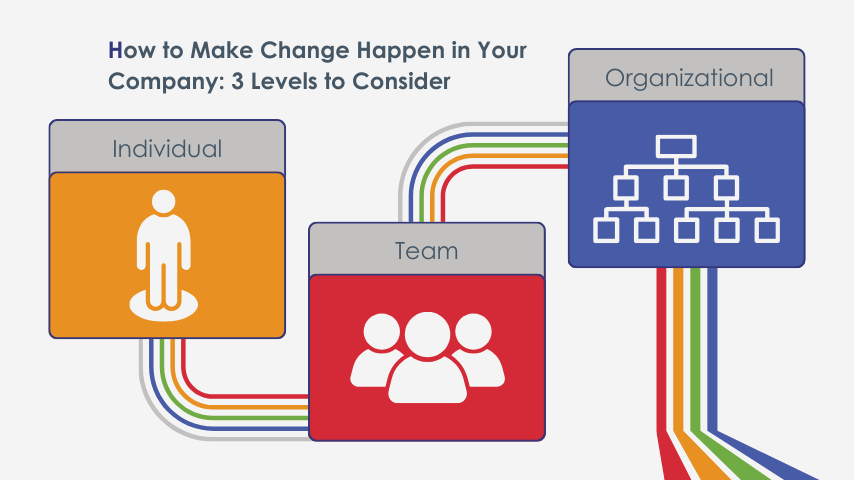Change is inevitable, and organizations that adapt to change are more likely to succeed. However, accomplishing change can be challenging, especially given that it can and must occur at the individual, team, and organizational level.
Barriers to Change: Challenges Across Individual, Team, and Organizational Levels
Individual Level
Individual resistance to change stems from innate factors like personality differences, values, and attitudes. While some naturally favor novelty and risk-taking, others gravitate towards stability and the known. Beyond personal predispositions, change can also induce fears—real and imagined—about the implications for one’s role, potential loss of competence, or the unknown. Addressing these fears and perceptions head-on, through communication and coaching can pave the way for smoother transitions.
Team Level
Change at the team level is frequently complicated by team dynamics. While beneficial for creativity, diverse team compositions can sometimes also mean clashing perspectives on change. A lack of trust or psychological safety within teams can hinder discussions about impending changes, causing misinformation and resistance. Encouragingly, teams that foster an environment of trust and psychological safety are more receptive to change and more effective in its implementation. Thus, leaders play a pivotal role in mediating and facilitating these environments.
Organizational Level
At the broader organizational level, entrenched cultures and structural rigidities often pose significant barriers to change. Organizations with histories of unsuccessful change attempts may witness skepticism among employees, impacting morale and receptiveness to new initiatives. Effective communication, particularly about the rationale for change, its benefits, and the roadmap for its realization, can mitigate some of this resistance. Moreover, investments in training can help realign the workforce’s skills and knowledge with the demands of the new direction, promoting a proactive culture of adaptability.
How to Accomplish Change at the Individual, Team, and Organizational Levels
Individual Level:
Understand Resistance: Recognize that resistance often comes from fear or misunderstanding. Addressing individual concerns directly can help in making the change more acceptable.
Skill Development: Provide tailored training sessions to equip individuals with the necessary skills and knowledge for the upcoming change.
Mentorship and Coaching: Assign coaches or mentors to guide individuals through the transition phase.
Team Level:
Build Trust: Conduct team-building activities to foster stronger interpersonal relationships, making members more receptive to collaborative change.
Autonomy: Empower teams by giving them some freedom in the change process. This can make them more invested in the outcome.
Idea Collaboration: Create platforms or sessions where team members can brainstorm and offer their perspectives on the change.
Organizational Level:
Culture Building: Establish a culture that is agile and welcomes change. Highlight stories and examples of successful changes in the past.
Transparent Communication: Ensure that the reasons for the change and the benefits are communicated to everyone in the organization. Regular updates can keep everyone aligned.
Continuous Learning: Invest in organization-wide training programs and workshops emphasizing adaptability and innovation.
In the face of ever-evolving global landscapes, the onus is on organizations to continually refine and reinvent their approaches to change. While individual, team, and organizational barriers can seem daunting, they are not insurmountable. By investing in a strategic blend of understanding, communication, training, and culture-building, organizations can navigate the complexities of change with agility and foresight. The key lies in recognizing the intricacies of each level, addressing concerns proactively, and fostering an environment where change is accepted and embraced. In doing so, organizations can set themselves up for sustained success in an unpredictable future, ensuring they remain relevant, competitive, and ahead of the curve.

